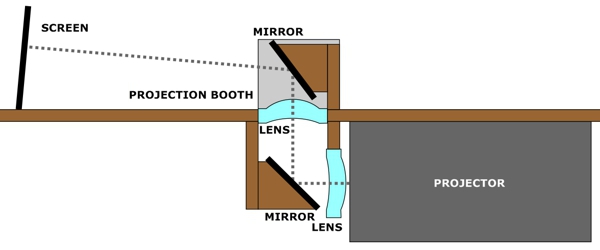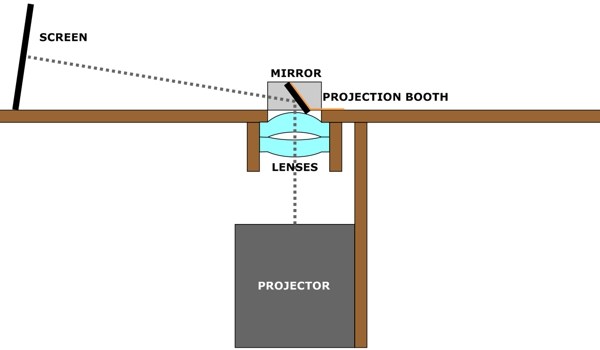Drive-In Theater
It's been a longstanding dream of mine to create a proper Drive-In Theater, so when the idea hit me to do one as a diorama, the project got pushed to the top of the to-do list. What's a "proper" drive-in? It's one where the image is actually projected on the screen, just the way it's done in real life, instead of using a miniature LCD display, which requires an entirely unconvincing disguise around the edges of a dead flat, vertical display. Instead, I can make a freestanding, curved and a scale size screen.
Here is the drive-in I was going to model, before that project was cancelled owing to health issues. But then the project was reborn courtesy of a major change in modeling direction.
First Generation Optics
 While the
projector I purchased might be more appropriate
for kids, it's surprisingly sophisticated: it accepts standard audio/video signals as well as HDMI; it has USB and micro-USB ports for streaming content;
and it has two image card slots to display photos and videos captured on cameras. Plus it will run on batteries or
a wall wart. That's an awful lot of tech to cram into a "toy" smaller than your fist that costs less than $35!
While the
projector I purchased might be more appropriate
for kids, it's surprisingly sophisticated: it accepts standard audio/video signals as well as HDMI; it has USB and micro-USB ports for streaming content;
and it has two image card slots to display photos and videos captured on cameras. Plus it will run on batteries or
a wall wart. That's an awful lot of tech to cram into a "toy" smaller than your fist that costs less than $35!
Paired with the projector is a super-cheap compact DVD player. The surprising thing about this $25 unit is that, short of Blu-Ray, it'll play just about anything you put in it, including NTSC and PAL discs coded for any region (it's a true region-free player). Which means my drive-in will be able to present some pretty esoteric entertainment! Foreign films, anyone?

Above is the optical configuration. It worked, but it was disappointingly small, dim and blurry. It would also have required a much larger than acceptable model projection booth. The main problem was that the distance between the projector and screen was quite limited. Below left is the projection unit, on top of which a base plate is attached. Below right is the revised lens/first-surface mirror arrangement to get the image topside and right side up. At the bottom is the result of the concoction: as a proof of concept, it was a success. But it was far from being ready for prime time.



Second Generation Optics
In order to correct the problems properly, I had to work up the courage to do some major surgery on the projector, and on 11 September 2021-2022 I did just that. I basically chopped the projector in half, stripping out all of the original optical parts. In particular, there was a large first-surface mirror right in front of the image element that was making things much more difficult than necessary, including the need for two mirrors to get the image topside and right side up; with that first big mirror out of the way, I could get by with just one small mirror mounted topside up against the lens for a nice compact optical configuration.

After spending some time hand-holding lenses and mirrors in front of the raw imager, I determined that I was on the right path. Below is the revised optical configuration. The arrangement allows for a greater distance between the projector and screen, producing a larger image that's also brighter and sharper than before, thanks to a better lens arrangement. While the lens is fixed in place, the projector and mirror are adjustable. Incidentally, the projection booth will also serve as a speaker enclosure.

Now, since there's no such thing as a free lunch, there had to be a price to pay for messing with the original optics, and in this case I'll have to live with a vignette effect, where the image exceeds the useful parts of the lenses. Honestly, I'm fine with it—I'm just tickled the thing still works after all after the cutting and hacking it's been through. Below I'm testing the projector using an envelope for a screen (the image is actually better than this photo suggests):

The other price to pay is a rather bulky assembly that measures almost 9 inches tall. Below left: the hacked up projector installed and ready for the show. Below right: the whole shebang.




Above left: Topside view of the lens, mirror, and speaker opening. Above right: the lens, back in its original barrel, and the speaker enclosure, which I chopped out of the discarded half of the projector case. The scratchbuilt screen is a scale 20 by 30 feet. And with this done, the rest is all cosmetics.

|
|
